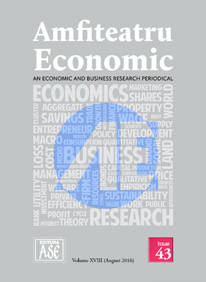
Some Thoughts on the Criteria of Nominal Economic Convergence in the EU Economy Near Us (XV)
In connection with the nominal economic convergence criteria, five comments can be made: a) on their completeness; b) on their representativeness; c) on their relevance (meaning); d) on their redundancy (non-synergy); e) on their effectiveness.
- Completeness
As is known, there are three “budgets" in the national economy or, better said, three balances: a) the balance of the public sector (consolidated general budget - CGB);
- b) private sector balance - PSB;
- c) the balance of the external sector (current account balance - CAB).
Between the three balances the economic equilibrium must be functioning, i.e. the internal balance (IB = CGB+PSB) is equal to the external one (EB = CAB), so CGB+PSB = CAB.
But, as in the Maastricht Treaty, only one of the three relative balances, namely CGB, is held, this balance is compatible with any pair of values of the other two balances. For example, if CGB = 0.03, as stipulated by the Maastricht Treaty, then we can write: CAB – PSB = 0.03. For example, this equation is verified, without the Maastricht Treaty being violated, by CAB = 0,45, and PSB = 0,42.
From an economic point of view, this means that almost half of the net domestic absorption of the country means import and, at the same time, that the country's private sector cannot cover its expenditure in proportion of more than 40% of GDP. Both situations (import and indebtedness to the private sector) are extremely serious vulnerabilities, although the Maastricht Treaty is rigorously respected.
The solution is obviously to complete the set of nominal economic convergence criteria with one of the other two balances. Our proposal is that the new nominal economic convergence criterion should be the current account balance as a share of GDP[i].
- Representativeness
It is not clear why the thresholds for some of the nominal economic convergence criteria have been chosen as they have been chosen. For the values of the government deficit, and for the total public debt, the justification is given by a simple algebraic model. However, it is not clear why the annual rate of nominal GDP was taken to be 5%, and 2% for inflation, respectively. These values, in turn, must be based on a quantitative model, which is not, however, the case. In our view, therefore, an analysis of the verification by the Eurozone Member States of the nominal economic convergence criteria, namely an analysis of the reasons why these criteria have not been observed or even flagrantly violated, could lead to a re-substantiation of these numerical ceilings. They apparently simply reflect an economic situation in a particular Member State at the time when the Maastricht Treaty was entering into force (early 1990s).
- Relevance (significance)
Regarding the significance of nominal economic convergence criteria, it can easily be shown that they do not clearly fulfil the role for which they were introduced: to control the evolution of the nominal economy in such a way that no serious distortions (and, perhaps, irreversible ones), happen as a result of the dynamic equilibrium (or possibly the sustainability).
The problem is that, in the Maastricht Treaty, the correlation of the budget deficit with the public debt and the nominal GDP growth rate is mathematically based on the stability/stationarity of this correlation, not on its sustainability. For example, a few simple simulations lead to the following conclusion: if the nominal annual growth rate of the GDP of 5%, and the share of the government deficit in GDP of 3%, are both valid, then two values are valid, not only one, for the share of total public debt in GDP: a) 60.1% (which we can approximate to 60%, as required by the Maastricht Treaty), and b) 65.1%.
For other cases (annual nominal GDP growth rates differing from 5%), we also record distorted (sometimes very large) values compared to the Maastricht Treaty. This instability of the set of nominal economic convergence criteria renders them incapable of ensuring their relevance (meaning).

- Redundancy (non-synergy)
From the theoretical point of view, the set of nominal economic convergence criteria should be considered as a system of sui generis “axioms" which, once verified, ensures that the Member State entering the euro area will not, through this entry, introduce vulnerabilities and risks in the real and nominal economy of the monetary area. If this can be said, then the five criteria should be independent of each other, i.e. one cannot be deduced from each other, or the variation of one of them does not directly affect the variation of another (either directly proportional or in inversely proportional mode). Unfortunately, this is not the case with the set of nominal economic convergence criteria proposed in the Maastricht Treaty.
- with regards to the monetary criteria:
- the change in inflation determines, on a straightforward basis, based on the Fisher relationship, the long-term nominal interest rate. Therefore, it is sufficient to verify (or break) the inflation criterion that, with a margin of uncertainty due to other causal factors, the long-term nominal interest rate criterion will, of course, be verified (or will be breached) [ii];
- the nominal exchange rate variation determines inflation proportionally, on the basis of the pass-through mechanism, namely by importing inflation. So, it is enough to verify (or break) the nominal exchange rate criterion to also break the inflation criterion, with a certain margin of uncertainty, due to other causal factors;
- therefore, by combining the two above-mentioned causal dependencies, the change in the nominal exchange rate determines, directly, the other two monetary criteria, as follows: the exchange rate → ↑ inflation → ↑ the long-term nominal interest rate.
- as regards fiscal-budget criteria:
- the variation in the general government deficit ratio in GDP determines, in a proportional manner, through the financing mechanism, the change in the total public debt ratio in GDP.
Based on the above, the suggestion that the nominal economic convergence criteria should be revised is strengthened.
- Effectiveness
The methodology for verifying the fulfilment of nominal economic convergence criteria of monetary type (in fact, only the criteria of inflation and the long-term nominal interest rate) implies a comparison of the EU Member States concerned with the simple arithmetic average of the best placed three EU Member States in terms of inflation. Here are two critical statements:
- by taking into account all EU Member States and not only euro area Member States, the benchmark obtained (the arithmetic mean of inflation in the EU Member States with the lowest inflation) may introduce a constraint greater than necessary for access to the euro area. Namely, if one, two or all three third countries in this respect are outside the euro area, the candidate country of the euro area has a greater constraint than is necessary, which is, from a theoretical point of view, equivalent to an adverse selection. It would therefore be necessary for the three states that form the benchmark to be members of the euro area, not only of the EU;
- apart from the ones mentioned in the previous point, there is still a problem, also of a methodological nature: setting the benchmark based on the arithmetic mean of the inflation of the three states is problematic, especially in the case (of course, unlikely, but in principle, possible) where the differences between the three numerical values of inflation are very high. Since the purpose of applying this criterion - inflation - is to lead to economic convergence (of a nominal type in this case), it would be more appropriate to use the median, not the mean. As can be easily shown, the median of an ordered numerical series is more representative for the idea of convergence than the arithmetic mean. Therefore, in this respect too, a review seems be required regarding the nominal economic convergence criteria.
[i] The numerical value of such a ceiling must, of course, be based on the extension of the mathematical model used to substantiate the five existing criteria to include the sixth (see below, discussion on the relevance/significance of the set of nominal economic convergence criteria). In the present study we do not undertake such a de ferenda analysis.
[ii] This situation is explicitly acknowledged by the Maastricht Treaty, which stipulates that the criterion called “long-term nominal interest rate" is based on the same group of EU Member States that were considered in the verification of the criterion “inflation". In other words, it is recognized that where there has been a certain evolution of inflation, it is expected that there has been a consistent evolution in terms of the long-term nominal interest rate.








